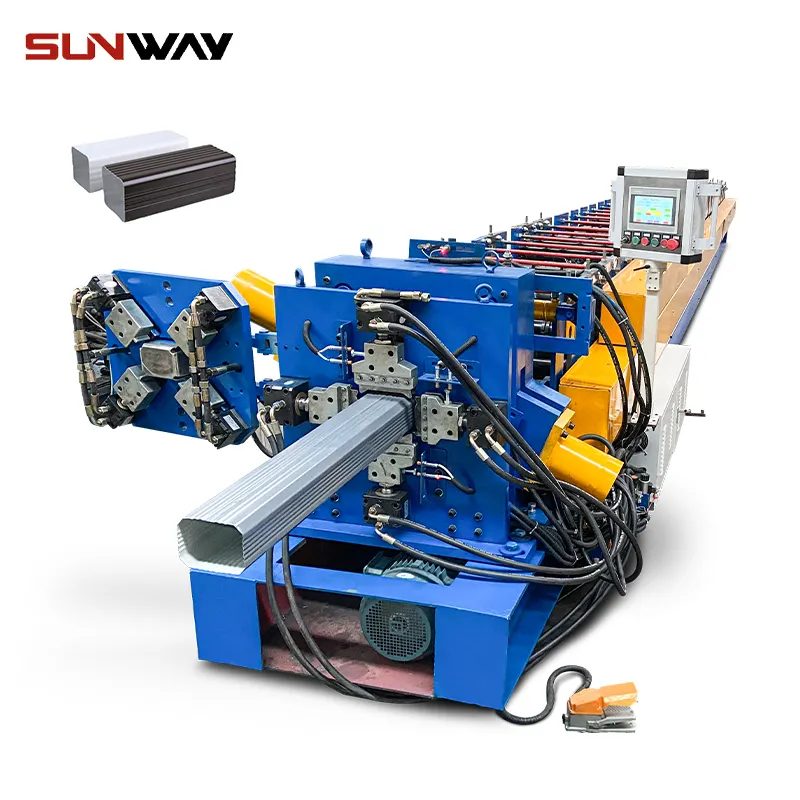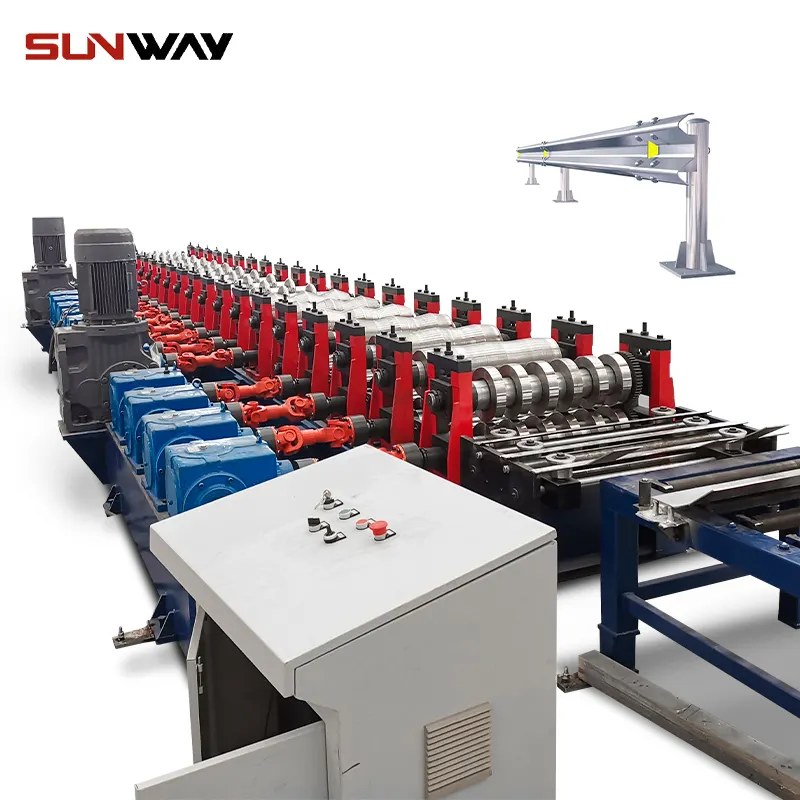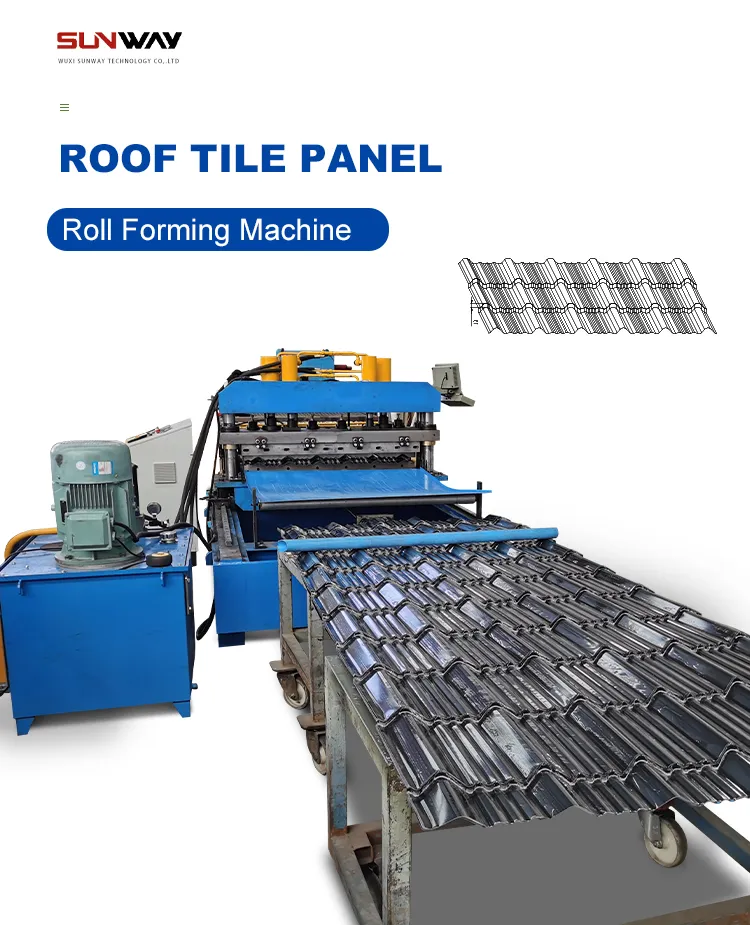परिचय
- Introduce the concept of steel roof roll forming machines
- Explain the importance and benefits of using these machines in the roofing industry
- Engage the reader with a rhetorical question about the efficiency of traditional roofing methods
Understanding Steel Roof Roll Forming Machines
- Explain what a roll forming machine is and how it works
- Describe the key components and features of a steel roof roll forming machine
- Highlight the different types of profiles and designs that can be produced with these machines
Advantages of Steel Roof Roll Forming Machines
- Discuss the cost-effectiveness of using roll forming machines for roofing projects
- Highlight the speed and efficiency of production compared to manual methods
- Emphasize the precision and consistency achieved by these machines
How to Operate a Steel Roof Roll Forming Machine
- Provide step-by-step instructions on setting up and operating the machine
- Include safety guidelines and best practices for operators
- Mention the importance of regular maintenance for optimal performance
Applications of Steel Roof Roll Forming Machines
- Explore the various industries and sectors where these machines are used
- Discuss the versatility of roll forming machines for different roofing materials
- Give examples of successful projects using these machines

Comparing Steel Roof Roll Forming Machines with Other Roofing Methods
- Compare roll forming machines with traditional roofing techniques
- Discuss the advantages and disadvantages of each method
- Explain how roll forming machines outperform other methods in terms of time, cost, and quality
Choosing the Right Steel Roof Roll Forming Machine
- Provide guidance on selecting the appropriate machine for specific roofing needs
- Consider factors such as production volume, material compatibility, and budget
- Mention reputable manufacturers and brands in the market
Trends and Innovations in Steel Roof Roll Forming Technology
- Discuss the latest advancements in roll forming technology for roofing applications
- Highlight any eco-friendly or energy-efficient features available
- Mention any future developments that may impact the industry
Success Stories of Using Steel Roof Roll Forming Machines
- Share real-life case studies of companies benefiting from these machines
- Include testimonials and feedback from satisfied customers
- Demonstrate the positive impact on project timelines and profits
Sustainability and Environmental Benefits
- Explain how steel roof roll forming machines contribute to sustainability
- Discuss the recyclability of steel and its impact on reducing waste
- Mention any certifications or eco-friendly initiatives related to these machines

Challenges and Troubleshooting with Steel Roof Roll Forming Machines
- Identify common issues that operators may face during machine operation
- Provide solutions and troubleshooting tips for these problems
- Advise on seeking professional assistance when needed
Future Prospects of Steel Roof Roll Forming Machines
- Discuss the growth potential and market outlook for these machines
- Analyze any potential challenges or opportunities in the coming years
- Predict how advancements in technology may shape the future of roll forming machines
निष्कर्ष
- Recap the benefits and significance of steel roof roll forming machines
- Encourage readers to consider using these machines for roofing projects
- End with a strong closing statement that leaves a lasting impression
Steel Roof Roll Forming Machine: Revolutionizing Roofing Industry
The roofing industry has witnessed significant advancements in recent years, and one machine that stands out as a game-changer is the steel roof roll forming machine. This innovative equipment has transformed the way roofs are manufactured and installed, offering numerous benefits that traditional methods struggle to match.
Understanding Steel Roof Roll Forming Machines
A steel roof roll forming machine is a specialized piece of equipment used to shape flat steel sheets into specific roofing profiles. The process involves passing the metal through a series of rollers that gradually bend it into the desired shape. The result is a continuous, perfectly formed roofing panel that can be cut to custom lengths. The ability to produce long, seamless panels is one of the key advantages of roll forming machines, as it reduces the number of joints and potential leak points in the roof.
Advantages of Steel Roof Roll Forming Machines
The advantages of using steel roof roll forming machines are manifold. First and foremost, they significantly reduce labor costs and production time. Unlike traditional methods where each roof component must be individually measured, cut, and shaped, roll forming machines can produce hundreds of feet of roofing panels per minute, making large-scale projects more efficient and cost-effective.
The precision and consistency achieved by roll forming machines ensure that each roofing panel is uniform, providing a high-quality finished product. This level of precision is challenging to achieve through manual methods, where human error can lead to inconsistencies.
How to Operate a Steel Roof Roll Forming Machine
Operating a steel roof roll forming machine requires some technical knowledge and skill. However, modern machines come equipped with user-friendly interfaces and automated controls that simplify the process. Operators need to ensure that the steel sheet is correctly loaded, adjust the settings to achieve the desired profile, and monitor the production for any issues.
Safety is paramount when working with roll forming machines. Operators must follow safety guidelines and wear appropriate personal protective equipment (PPE) to avoid accidents during operation.

Applications of Steel Roof Roll Forming Machines
The applications of steel roof roll forming machines are diverse. These machines are widely used in the construction industry for commercial and residential roofing projects. Additionally, they are utilized in the manufacturing of agricultural structures, warehouses, and industrial buildings.
Roll forming machines can handle various materials, such as galvanized steel, aluminum, and stainless steel, making them suitable for different climates and environmental conditions.
Comparing Steel Roof Roll Forming Machines with Other Roofing Methods
When comparing steel roof roll forming machines with traditional roofing methods, the advantages are evident. Traditional methods involve extensive manual labor, which is time-consuming and labor-intensive. Moreover, manual cutting and shaping can lead to waste and increased material costs.
On the other hand, roll forming machines offer unmatched speed and efficiency. They eliminate the need for multiple manual processes, reducing the risk of errors and waste. The precise and uniform output ensures a better-finished product that meets or exceeds industry standards.
Choosing the Right Steel Roof Roll Forming Machine
Selecting the right steel roof roll forming machine is crucial to the success of any roofing project. Factors such as production volume, desired profiles, and material compatibility must be carefully considered. It’s essential to invest in a machine that aligns with the specific requirements of the business to maximize productivity and return on investment.
Leading manufacturers offer a range of roll forming machines with various features and capabilities, allowing roofing companies to choose the best fit for their needs.
Trends and Innovations in Steel Roof Roll Forming Technology
The steel roof roll forming industry has witnessed significant technological advancements. Manufacturers are continually improving their machines to enhance productivity, reduce energy consumption, and optimize the use of raw materials. Some machines are now equipped with smart technology that allows for remote monitoring and real-time data analysis, enabling operators to make data-driven decisions and identify potential issues before they escalate.
Additionally, there is a growing focus on sustainability and environmental responsibility. Manufacturers are exploring ways to incorporate eco-friendly materials and reduce waste during the production process.
Success Stories of Using Steel Roof Roll Forming Machines
Numerous success stories from companies using steel roof roll forming machines demonstrate the tangible benefits of this technology. Roofing contractors have reported completing large-scale projects in record time, resulting in increased profits and improved customer satisfaction.
One such success story comes from a roofing company that was contracted to replace the roofs of several warehouses. By using a steel roof roll forming machine, they were able to complete the project ahead of schedule, delivering a flawless roofing solution to their client. The machine’s ability to produce long panels with minimal seams meant faster installation and reduced labor costs. As a result, the roofing company was able to take on more projects, further boosting their reputation and business growth.
Sustainability and Environmental Benefits
The environmental benefits of using steel roof roll forming machines are noteworthy. Steel is a highly recyclable material, and the roll forming process generates minimal waste compared to other roofing methods. This reduces the overall ecological footprint of roofing projects and contributes to sustainability efforts.
Additionally, steel roofs have a long lifespan and are highly resistant to weathering, reducing the need for frequent replacements. This not only saves costs for property owners but also helps conserve resources in the long run.
Challenges and Troubleshooting with Steel Roof Roll Forming Machines
While steel roof roll forming machines are efficient and reliable, they are not without their challenges. Operators must be aware of potential issues that may arise during production. Common problems include material jamming, misaligned rollers, and power fluctuations. However, these challenges can often be addressed with proper maintenance and troubleshooting techniques.
Training operators and maintenance personnel is essential to ensure smooth and trouble-free operation. Regular inspections and preventive maintenance can help identify and resolve potential issues before they lead to costly downtime.
Future Prospects of Steel Roof Roll Forming Machines
The future of steel roof roll forming machines looks promising. As technology continues to advance, these machines are likely to become even more sophisticated and efficient. Manufacturers may integrate artificial intelligence and automation to further streamline the production process and enhance productivity.
Moreover, the demand for sustainable and eco-friendly construction practices is expected to grow, driving the adoption of steel roof roll forming machines. As more industries and regions embrace environmentally responsible practices, roll forming technology will play a vital role in meeting these demands.

निष्कर्ष
The steel roof roll forming machine has revolutionized the roofing industry, offering unparalleled speed, efficiency, and precision in producing roofing panels. This advanced technology has become a game-changer for roofing contractors, enabling them to take on larger projects and deliver high-quality results to their clients.
By streamlining the production process, reducing waste, and promoting sustainability, steel roof roll forming machines contribute to a greener and more eco-friendly construction sector. As the demand for sustainable practices grows, these machines will continue to play a crucial role in shaping the future of roofing and construction.
Investing in the right steel roof roll forming machine can significantly impact the success and profitability of roofing businesses. By staying updated on the latest trends and innovations in roll forming technology, companies can make informed decisions and stay ahead of the competition.
FAQs
- Are steel roof roll forming machines suitable for small-scale projects?Yes, steel roof roll forming machines come in various sizes and capacities, making them suitable for both small-scale and large-scale projects. Whether you need to manufacture roofing panels for a single residential property or an expansive industrial complex, there’s a roll forming machine to fit your needs.
- What materials can be used with a steel roof roll forming machine?Steel roof roll forming machines can handle a wide range of materials, including galvanized steel, aluminum, and stainless steel. Each material offers specific benefits in terms of durability, weight, and cost, allowing roofing contractors to choose the most suitable option for their projects.
- Is training required to operate a steel roof roll forming machine?Yes, proper training is essential for operators to safely and efficiently operate a steel roof roll forming machine. Manufacturers often provide training and guidelines for machine operation and maintenance. It’s crucial to ensure that operators are familiar with the machine’s controls and safety procedures to avoid accidents and maximize productivity.
- How long does it take to set up a steel roof roll forming machine for a new profile?Setting up a steel roof roll forming machine for a new profile typically takes some time, depending on the complexity of the design. It involves adjusting the rollers, guides, and other components to match the desired profile. With experience, operators can streamline the setup process, but it’s essential to allocate sufficient time for initial adjustments.
- Can steel roof roll forming machines produce custom-designed profiles?Yes, steel roof roll forming machines can produce custom-designed profiles according to specific project requirements. They are highly versatile and can create a wide range of roofing profiles, allowing contractors to offer unique and tailored solutions to their clients. Custom designs may require additional setup time and adjustments but provide flexibility and creative freedom in roofing projects.
